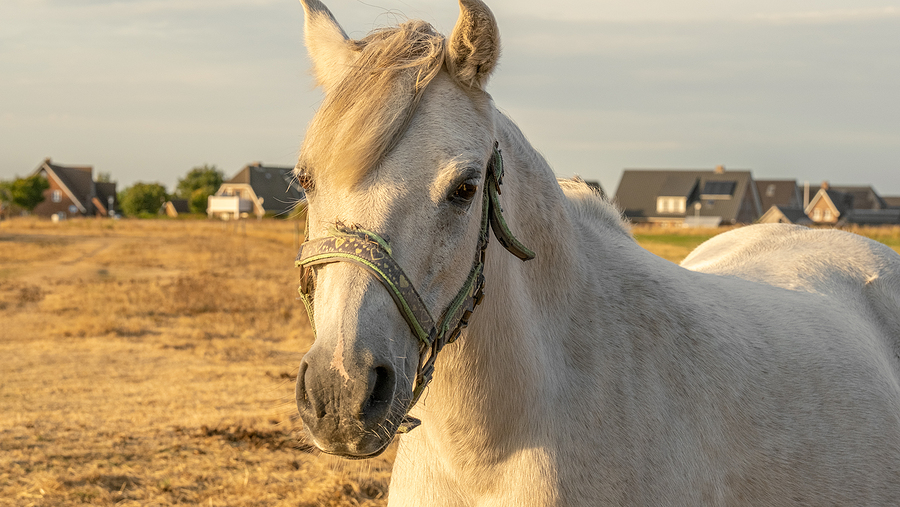Horses with asthma have trouble breathing, just like their human counterparts. This is caused by inflammation and narrowing in the horse’s lower airway and is usually triggered by an allergic reaction to dust or mold found in hay and bedding. Since wild horses rarely come into contact with these elements, this condition is considered a disease of domestic equines.
In some cases, horses kept on pasture can also develop asthma due to seasonal allergies. The pollen found in pasture grasses can be a trigger for horses sensitive to these allergens.
Horses with moderate to severe asthma usually show an increased respiratory rate and occasional coughing while at rest. They may also have nasal discharge and an intolerance for exercise and may struggle to breathe. Horses that have suffered with asthma for some time can develop a “heave line,” which is a horizontal contour that runs below the bottom edge of the ribs. This is caused by the horse’s abdominal muscles becoming enlarged as the muscles work hard to help the horse breathe. Loss of appetite and weight loss can also be experienced by horses severely affected by asthma.
Diagnosis
In addition to affecting a horse’s performance, asthma can also create considerable stress in a horse.
“The feeling of not being able to get enough air in your lungs is very distressing,” says Tamara Grubb, DVM, Associate Clinical Professor of Anesthesia & Analgesia in the College of Veterinary Medicine at Washington State University, a certified acupuncturist, and a member of the Board of Directors of the International Veterinary Academy of Pain Management. “It is called ‘air hunger’ and can lead not only to distress but also to dizziness and other complications due to lack of oxygen. Sometimes it is also painful to breathe during an asthma attack, which adds to the distress.”
Recognizing that your horse may be suffering from asthma is the first step in finding help for your equine companion. While seeing your horse struggling to breathe is the most obvious sign of the condition, more subtle behaviors may be your first clue.
“More subtle signs are the horse standing with the neck and head extended out, and often with the mouth open, while trying to breathe,” says Dr. Grubb. “The abdomen may also move during breathing, which is abnormal. And muscle lines can develop along the abdomen and chest with chronic asthma. While these symptoms could also be signs of other causes of difficulty breathing, the owner should immediately consult with a veterinarian.”
Veterinarians diagnose asthma in horses based on the symptoms and an exam. In some cases, vets can order diagnostic tests to confirm and learn more about the horse’s lower airway issues, including an upper airway and tracheal endoscopy, a bronchoalveolar lavage (BAL), pulmonary function testing, thoracic radiographs, and ultrasound. These tests are often ordered if a horse suspected of having asthma does not respond to treatment.
Treating Asthma
The best way to ease an asthmatic horse’s stress is with treatment, and fortunately, a number of treatment options are available for horses suffering from this condition. Inhaled bronchodilators and corticosteroids help open the horse’s airways and reduce inflammation, making it easier for him to breathe.
The good news is that the medications given to horses with asthma are unlikely to cause any behavioral side effects, according to Grubb.
“In fact, the horse’s behavior will likely go back to normal once it can breathe again,” she says. “But every horse is an individual so if there is concerning behavior, consult your veterinarian.”
Just as important as medication in treating equine asthma is environmental management. Without changing the horse’s environment and possibly diet, symptoms will likely return after a horse has been taken off medication.
“Medication is used more for flare-ups, while environmental modification is used for long-term control,” says Grubb. “Sometimes the cause is dust in the barn and in the hay, so decreasing dust through ventilation and soaking hay in water or feeding pelleted food might be suggested. Or the cause could be from pollens in the pasture, so limited pasture time might be the answer for some horses.”
Horses with barn-associated asthma do best if they are allowed to be on pasture or at least kept outdoors with minimal exposure to dust. Horses with asthma should not be fed from round bales either, as this hay tends to be high in dust and mold. Asthmatic horses who live in barns should be stabled far away from where hay is stored and should be kept on low or no dust bedding.
For horses with asthma caused by seasonal allergens, pasture time should be restricted, especially during spring, summer, and fall. Be aware of how changes in management or housing may affect your horse. Restricted pasture time can be stressful because it limits your horse’s ability to engage in natural behavior. As much as possible, try to balance management of seasonal allergens with providing for your horse’s welfare.
Equine asthma can cause a lot of stress for your horse, but with proper diagnosis, medication and environmental management, this condition can be successfully managed.
This article was reviewed/edited by board-certified veterinary behaviorist Dr. Kenneth Martin and/or veterinary technician specialist in behavior Debbie Martin, LVT.
Audrey Pavia is a freelance writer and author of Horses For Dummies and Horseback Riding for Dummies. She lives in Norco, California, with her two Spanish Mustangs, Milagro and Rio.
Want to stay in the loop on the latest and greatest in keeping your pet happy and healthy? Sign up for our free newsletter by clicking here!








